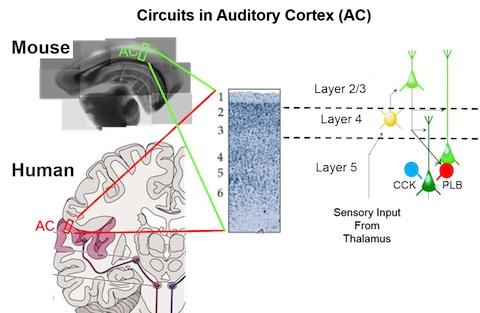Kimberly Huber, Ph.D. and Jay Gibson, Ph.D. at UT Southwestern will study the molecular and synapticmechanisms underlying cortical circuit hyperexcitability in auditory cortex (A1) of the Fmr1 knockout(KO) mouse.
The role of specific neurotransmitter receptors, ion channels and cellular signaling pathways will be tested for their contribution to hyperexcitability and the role of distinct synaptic circuits will be examined. Targeting these mechanisms, the researchers will test pharmacological and genetic strategies to correct hyperexcitability.

Recent Publications
- Guo W., Ceolin L., Collins K. A., Perroy J., Huber K. M. Elevated CaMKIIα and hyperphosphorylation of Homer mediate circuit dysfunction in a Fragile X Syndrome Mouse Model. Cell Rep 13, 2297-311, (2015).
- Patel A. B., Loerwald K. W., Huber K. M., Gibson J. R. Postsynaptic FMRP promotes the pruning of cell-to-cell connections among pyramidal neurons in the L5A neocortical network. J Neurosci 34, 3413-18, (2014).
- Patel A. B., Hays S. A., Bureau I., Huber K. M., Gibson J. R. A target cell-specific role for presynaptic Fmr1 in regulating glutamate release onto neocortical fast-spiking inhibitory neurons. J Neurosci 33, 2593-604, (2013).
- Ronesi J. A., Collins K. A., Hays S. A., Tsai N. P., Guo W., Birnbaum S. G., Hu J. H., Worley P. F., Gibson J. R., Huber K. H. Disrupted Homer scaffolds mediate abnormal mGluR5 function in a mouse model of fragile X syndrome. Nat Neurosci 15, 431-40, (2012).
- Hays S. A., Huber K. H., Gibson J. R. Altered neocortical rhythmic activity states in Fmr1 KO mice are due to enhanced mGluR5 signaling and involve changes in excitatory circuitry. J Neurosci 31, 14223-34, (2011).